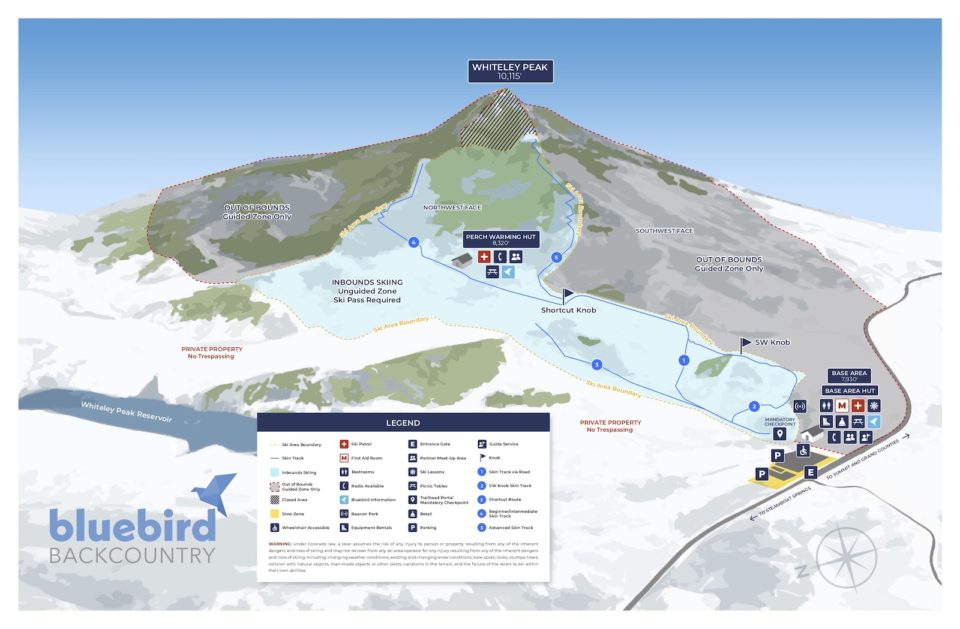The Local newsletter is your free, daily guide to life in Colorado. For locals, by locals.
The night before Bluebird Backcountry launched its initial Kickstarter campaign, co-founder Erik Lambert was panicking at the possibility that the concept would be a total flop. The idea? A ski area with no chairlifts or lifts of any kind, where all turns must be earned. North America’s first truly human-powered ski area.
After spending the last two winters soliciting feedback and vetting landscapes across Colorado where they might open such a place, Lambert and Bluebird Backcountry co-founder Jeff Woodward chose Peak Ranch, a private 1,500-acre spread of aspen-gladed slopes on 10,115-foot Whiteley Peak, located between Kremmling and Steamboat Springs.

Opening Saturday, February 15, Bluebird will operate for a total of 15 days through March 15. No more than 300 visitors are allowed on any given day and a day pass (not a lift ticket) is $50. Passes were initially sold through a Kickstarter campaign launched at the end of January, and the remaining tickets are still available on Bluebird’s website.
(Read more about how Bluebird Backcountry came to be)
“I was biting my nails, wondering if this would be a small campaign where we barely reached our goal or if it would gain a lot of public interest and momentum,” Lambert says. “We’re excited to put our moonshot idea out there, but it’s a huge experiment.”
In 48 hours, Bluebird sold through a quarter of its available day passes and, as of February 10, had sold through about half, with more than 1,000 backers pledging close to $110,000.
“It was what I was hoping for,” Lambert says. “It’s a tricky thing because this is a different concept for skiing. It’s hard to gauge whether it’s something that lots of people want to try or something that’s a really niche-y type thing.”
Only 100 guests—season pass holders and another limited few —have access to Bluebird this opening weekend.

“Our last day is March 15. We’re doing mostly weekends, also Presidents’ Day, and four-week days in March. We want to have fewer people the first few days so we can dial in our operation,” Lambert says.
The operation is simple. It’s comprised of a parking lot off of U.S. Highway 40 with a semi-permanent building where guests check in and get information about snow conditions and weather forecasts. A variety of equipment—alpine touring skis, splitboards, skins, and boots, as well as avalanche beacons, shovels, and probes—will be available to rent, and guests embarking on their first backcountry experience can get a lesson on avalanche danger and how to use the gear. Every skier—regardless of ability—is required to carry a working avalanche beacon.
Anyone with a $50 day ticket or a $250 season pass can then begin the scenic journey of earning their turns—passing through a checkpoint where a beacon park is available for testing avalanche rescue skills. From there, a series of skin tracks allow access to Bluebird’s 300-acre, 1,500-vertical-foot, “in-bounds” area of low-angle, aspen-strewn slopes, or, if guests hire a guide ($950 for a group of up to six), the full 1,500 acres of Bluebird’s terrain, including the summit of Whiteley Peak and a total of 2,200 vertical feet. About a half-mile up from the base lies another semi-permanent structure—the Perch—serving as a “mini-lodge” and warming hut with packaged snacks, warm drinks, and porta-potties.
In total, Bluebird Backcountry is operated by about a dozen staff members—including ski patrol who evaluate and mitigate the terrain for avalanche danger (using ski cutting and weight techniques, but no bombs or machines)—as well as volunteers.
“If someone is new to it, they’ll do one big lap or maybe two,” Lambert says. “Experienced backcountry skiers will do between two and eight laps in a day. We welcome anyone with fitness and ski experience. If you can ski a blue run and are fit and excited about going uphill, you’re welcome here.”
Lambert has been an avid backcountry skier since an impromptu–and rather naïve–trip up New Hampshire’s Mt. Washington back in 2001.
“My college buddy, who had no formal avy training said, ‘We should go backcountry skiing on Mt. Washington.’ I said, ‘That sounds, fun. What do I need?’ I went out and ordered a bunch of gear,” Lambert says. “We skied a spot called the Gulf of Slides…over a bunch of trees knocked out by avalanches. I was like, wow, that’s the power of nature. I didn’t put two and two together. It didn’t dawn on me until later how oblivious I was.”
Nearly two decades later, Lambert is fulfilling a dream of providing a safe and accessible backcountry experience for like-minded skiers and snowboarders. “My first experience speaks to how people don’t know where to begin. They’re looking to get away from crowds at resorts, get into the soul of skiing, have a fitness experience, and a wilderness experience. We believe we can solve all of that in one place.”
(Read our guide on how to safely get into backcountry skiing)








